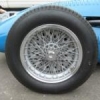Seanspeed, on 20 May 2018 - 00:33, said:
The more downforce a car has, the more it requires optimal quality and quantity of air to work at its best. If you take away or disturb that air, the car is going to suffer no matter how or where that downforce is being produced. And the more downforce it *can* or is *built* to produce, the more it is proportionately affected.
Making F1 cars race closely again is no problem. You just need to massively reduce the downforce. They'll be slow as hell, but they'll be able to race closely again.
There's no getting around this. You cant have it both ways.
I was scrolling through the posts with my contribution ready to be tapped out when I noticed Seanspeed's comment. And he's pretty much spelled out my position.
The opening post, and most of the subsequent posts, describe a strategy for reducing downforce and as we've observed over the years designers, aerodynamicists and code writers have been highly successful at finding their ways around every strategy the regulators have come up with.
The objective has long been to reduce downforce and its hand maiden, a large wake of disturbed air. Because if you can successfully achieve that, you gain several useful benefits. Among them are:
• Cars can follow more closely, facilitating overtaking.
• Braking distances will be longer - the cars no longer mashed into the track - again facilitating more overtaking.
• We can say goodbye to that absurd artifice, the DRS.
• Cornering speeds will be lower, thereby reducing the need for some of the gigantic runoff areas we have been seeing in recent years.
• Straightline speeds will probably be higher, again placing a premium on skilful braking.
• The cars will visibly squirm, wriggle and move around. They will not look as though they are on rails. And this, I contend, is what produces the "Wow!" factor with spectators and viewers.
• The whole equation of driver input vs engineering input will swing significantly towards the driver. And despite what those of us fascinated by the cleverness of the designers think, I believe it is the case that most followers of motor racing, particularly most casual watchers, primarily follow or support a driver rather than a team.
You do this, by the way, by mandating a maximum downforce acting on the car by way of data collected at each hub, and transmitted to race control in real time. This is technically feasible, I believe. The detailed implementation can be debated but I imagine race control would be alerted automatically in the event of a car exceeding the (downforce) limit with, say, a maximum of three alerts in a race before you cop some sort of penalty. The downforce limit, like Seanspeed suggests, should be way lower that it is at present. Sufficiently low that however you go about meeting the requirement, your car will not have an area of disturbed, low pressure air several car lengths behind it.
Purists will no doubt remind me that F1 is supposed to be the pinnacle of the sport and should have as few regulatory constraints as possible. Back when I was first bitten by the F1 bug - the 1960s - the best technology practically available was both affordable and did not threaten to render racing boring. I was all for relatively few regulations to constrain innovative thinking. Today, as we've seen, the best technology is outrageously expensive and unfettered, would bring with it the need for drivers to wear g-suits to deal with the g forces of 7g and above, braking distances would be even shorter, spectator protection, including run-off areas, would need to be even greater. Without doubt, sadly, a (regulatory) line needs to be drawn in the sand. So today, my 1960's zeal for relatively few regulations has given way to a need to more carefully balance the factors of engineering excellence and entertainment.
Others will say that you will kill F1 if it becomes slower. I reject that argument. I recall standing shoulder to shoulder with 100,000 others at Silverstone and Brands Hatch watching Formula One races with cars very considerably slower that today's brilliant showcases of engineering genius.
Sepang is one circuit that has hosted both F1 and Moto GP on the same layout. Pole position at the 2017 F1 Malaysian Grand Prix was 1'30.076". At the 2017 Moto GP Malaysian Grand Prix it was, 1'59.212". Half a minute slower. I don't notice Moto GP fans around the world lamenting how slow their sport is.
A design challenge?, others may ask. My response is that even though they are being asked to work with significantly reduced downforce, the challenge is still there to optimise its mechanical grip, its speed vs downforce compromise, its braking, its balance and of course, its entire powertrain. Plenty of challenge there.
































